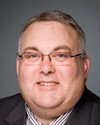Yes, absolutely.
If I may, Mr. Chair, with your permission, I will indicate that on the map my current boundary comes down like this, then over here, in essence, and it includes the area of High Prairie, Slave Lake, and Athabasca.
Wabasca is north of Athabasca. In fact, the only way you can get to Wabasca is through Athabasca, through High Prairie, or through Slave Lake, which have highways connecting to them. In fact, that is the trading area. It is an economic trading area and a family trading area. I would suggest that they do most of their shopping in Athabasca, High Prairie, or Slave Lake, with absolutely no connection to Fort McMurray. If you want to go to Wabasca, you have to travel down Highway 63 or Highway 881 over to Athabasca, and then straight back up, which gets you a lot closer to Wabasca, but of course there is no connection.
As there is no connection by highway except through Athabasca, my argument is simply that there's no benefit to including it there. It's a smaller community. In fact, my suggestion is to include only the Regional Municipality of Wood Buffalo.
I'll be very brief on that, Mr. Chair, if you could give me an idea of when my time is at one minute.
The Regional Municipality of Wood Buffalo has 63,000 square kilometres. My constituency has 180,000 square kilometres. My argument today is based on the federal census, which I do not believe is accurate—I'm just going to do it in summary—and that is primarily because of their data collection techniques.
In Fort McMurray, as you may be aware, most people do shift work. They work 12-hour shifts. Consistently, we have the lowest voter turnout in the country, year over year. In fact, for that low voter turnout in 2008, when I did a survey of my constituents, 52% came back and said they couldn't vote because of work. We all know the reality of that. Their situation or their perception is they're not going to work a 12-hour shift and then return to vote on something, and most of them, since the average age is 29, are not great at voter turnout.
The municipality of Wood Buffalo also did a census for 2010. The federal census came in at 66,000. The municipality of Wood Buffalo census came in at just over 103,000. There is a discrepancy of over 25%.
If you believe the federal census, then you have to suggest that the Regional Municipality of Wood Buffalo should be included with other areas. If you do not believe that census and you think there is an issue with it, by the Regional Municipality of Wood Buffalo census there will be 150,000 residents by 2015 in the Regional Municipality of Wood Buffalo, and by 2025 they will have 304,000 constituents in the Regional Municipality of Wood Buffalo, which is only approximately one-third of my entire constituency as proposed by the commission.
That is the difficulty. Even with the federal census, based upon their suggested increase, by 2025 there will be 140,000 people in that riding just in the Regional Municipality of Wood Buffalo.
In saying all this, I am in agreement with my colleagues, Mr. Warkentin and Mr. Storseth, relating to the particulars of the boundary redistribution that they have proposed and that most of the Alberta caucus has proposed. My only suggestion is that the boundary should be Highway 63, which is the highway that best represents Fort McMurray and goes straight south, as the map indicates. As that roadway is there, and based upon what is necessary in Alberta, this particular line shown on the south can go north and south, depending upon what you need.
What I'm suggesting to you today, in conclusion, is that Fort McMurray is one of the fastest-growing areas in the country year over year, and I think that growth and the recognition of all the projections that suggest the population is going to be over 250,000 by 2025, which will be the next division, suggest that there should be special consideration for this particular area, especially in giving regard to economic growth.
Thank you.





